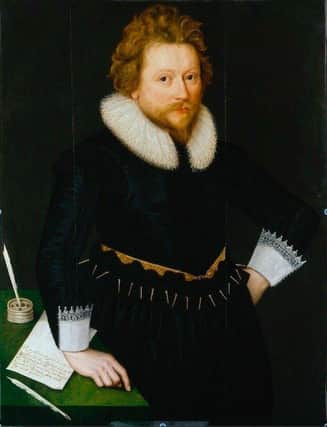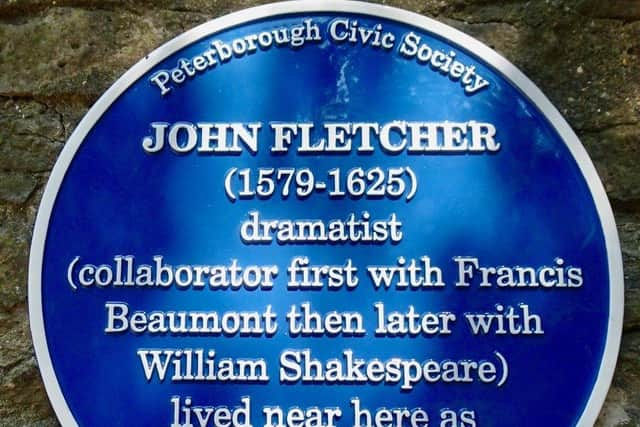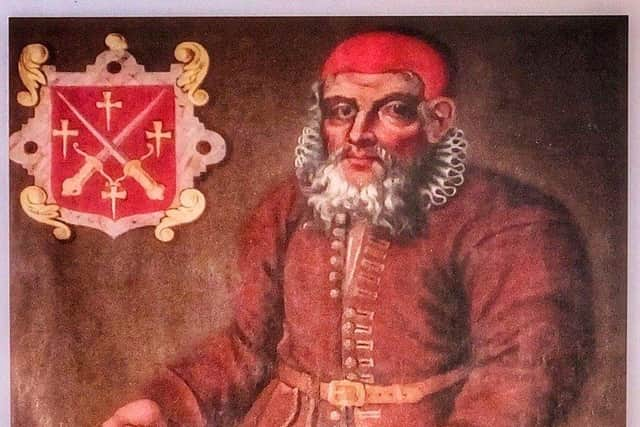The Peterborough schoolboy who went on to write with Shakespeare


This plaque to John Fletcher is affixed to the wall just west of the end of the former Deanery within the Cathedral precincts.
John Fletcher was born in 1579 at Rye, Sussex, the third son of Richard Fletcher who, a few years later, would become Dean of Peterborough.
Advertisement
Hide AdAdvertisement
Hide AdIt was Dean Fletcher who would disturb the last moments of Mary Stuart, Queen of Scots, at her execution at Fotheringhay in 1587 with the cry: “So perish all the Queen’s (Elizabeth’s) enemies.”


By the later 1580s young John, then a schoolboy living at the Deanery and receiving his education within its precincts, must have encountered the aged Robert Scarlett, the celebrated sexton.
‘Old Scarlett’ whose remarkable career is commemorated on the inside of the west wall of the cathedral’s nave, had been responsible for conducting the burials of queens Katharine of Aragon and Mary, Queen of Scots.
It is perfectly plausible that the old sexton would have regaled the young and impressionable John with macabre tales drawn from his experiences working within what was a grossly overcrowded graveyard.
Advertisement
Hide AdAdvertisement
Hide AdJohn came of a literary family. After completing an education at Cambridge, he would soon be found in London collaborating with Francis Beaumont, an acquaintance of the dramatist Ben Jonson.


Beaumont and Fletcher’s collaboration lasted for about a decade, producing around 15 plays, until Beaumont’s death in 1616. Fletcher collaborated with other playwrights too, though at least 16 plays are considered to be from his pen alone.
Debate continues as to individual authorship of these collaborations, notably that between John Fletcher and that slippery literary enigma William Shakespeare.
The likelihood is that Fletcher and Shakespeare jointly produced ‘The Two Noble Kinsmen’ and shared in the composition of Henry VIII, “almost Shakespeare’s last word to the world”.
Advertisement
Hide AdAdvertisement
Hide AdShakespeare, who was probably in London by 1590, seems at some point to have had a house in St Andrew’s Hill, Blackfriars. A few yards away was the Blackfriars Theatre which, from about 1608, was taken over for the use of the ‘King’s Men’, a theatre company operated by a syndicate which included Shakespeare and Burbage and, later, Fletcher.
Nearby, too, was ‘The Mermaid Club’ a convivial watering-hole for a charmed circle including Jonson, Donne, Shakespeare, Beaumont and Fletcher.
Many were the ‘wit combats’ enjoyed by this sort of company so it is not surprising that a local tradition has grown that Fletcher could well have seeded in Shakespeare’s mind the imagery expressed in the Graveyard scene in Hamlet, drawing on his own schoolboy recollections of Old Scarlett’s macabre tales.
Hamlet watches the gravedigger pick up a disinterred skull from the freshly dug grave; recognising it as that of Yorick, the former Court jester, Hamlet exclaims, “Alas poor Yorick, I knew him, Horatio; a fellow of infinite jest, of most excellent fancy …”.
Advertisement
Hide AdAdvertisement
Hide AdPeterborough’s own Yorick was Edward, a youth from Crowland, who, having enjoyed a career as one of the King’s (Henry VIII) ‘fools’ returned to Peterborough.
An entry in St John’s Parish Register for a burial in July 1563 relates: “Item Edward the foole was buryed the xii day.”
John Fletcher died of the plague in 1625 and is buried in what is now Southwark Cathedral, alongside Shakespeare’s brother, Edmund.
This plaque is one of a series of 15 blue plates recently installed in central Peterborough by Peterborough Civic Society.
Advertisement
Hide AdAdvertisement
Hide AdThe new series of plaques augments the 20 existing plaques in the city centre. Further details about all the plaques can be found in the accompanying 28-page booklet which can be ordered on the Society’s website at a price of £2 per copy (to cover postage and packing).
Once the Covid-19 lockdown restrictions are relaxed, copies of the booklet will be available to collect free of charge at the Town Hall and other outlets. A download of the booklet is available on the society’s website.
The plaques project has been supported by the National Lottery Heritage Fund and Peterborough City Council.